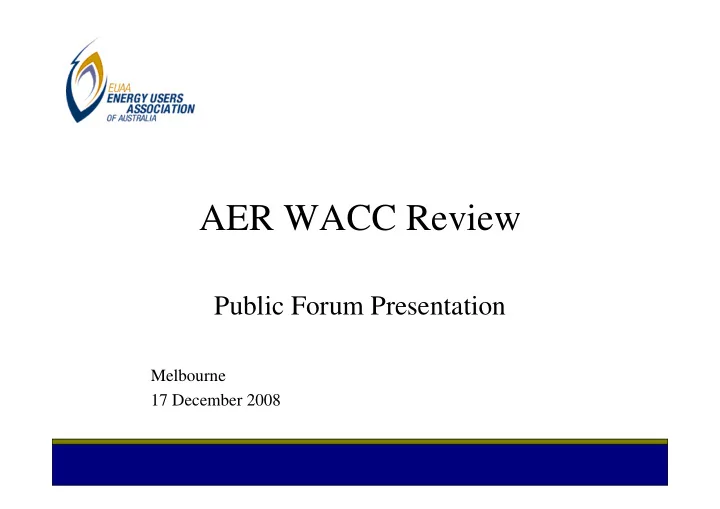

AER WACC Review Public Forum Presentation Melbourne 17 December 2008
Structure of This Presentation � Equity beta � Impacts on end users … In the limited time available not possible to comment on the full report or all parameters … would be better prepared if more time allowed 2
Prof Martin Lally’s Advice to EUAA … � Equity beta � Gamma � Risk free rate … provided to AER as part of this review 3
Equity Beta & AER Review � The AER staff and their advisors are to be congratulated on a methodical and thorough analysis. In the short time we have had to review the explanatory report, we suggest that they have produced a reasonable and professional analysis. � But the AER’s proposal, despite the clear conclusions provided by its analysis, is at odds with the analysis and completely without merit. We are perplexed by this and strongly believe that the final conclusions need to consistently reflect the analysis. 4
AER’s Interpretation of Its Obligations Under the Rules � AER thinks that it should not change the equity beta (or other parameters) unless there is persuasive evidence that the existing value is wrong. � The AER suggests persuasive evidence means: “ verifiable empirical market evidence and theoretical reasons, so long as they are well founded, which when relied upon suggest one particular conclusion should be adopted over other competing conclusions ”. � This is a sensible basis on which to proceed. But the AER’s proposals are not consistent with its own analysis. 5
AER’s Key Conclusions Risks to be valued: Equity beta to account only for non-diversifiable risk � Regulatory form: CPI-X, pass-throughs and asset base roll-forward means that regulated � businesses face a lower degree of non-diversifiable risk � Choice of comparators: exclude Gasnet and Alinta because prices affected by M&A International comparators: Exercise extreme caution � Data exclusion : Data from technology bubble period not representative and so excluded � Observation frequency : weekly � � Thick and thin trading: Use Dimson’s approach Confidence intervals : the need for persuasive evidence does not translate into specific statistical � hypotheses for the selection of standard errors Blume and Vasicek adjustments: Not appropriate – if the true equity beta of a benchmark � efficient service provider is below 1, the application of either adjustment is likely to bias estimates upwards Use of portfolio, average or median : diversity of approaches is appropriate – no basis to rely on � only one The analysis of the AER staff and their advisors on these issues is well founded. 6
Equity Beta Results OLS LAD AER’s consultant (Professor Henry) (re- 0.58 0.43 levered, weekly observations) JIA’s consultant (ACG) (re-levered, 0.61 0.55 monthly observations) AER (re-levered, average portfolio) 0.44 0.44 AER notes: • Highest average is well below the previously adopted equity beta of 0.9 or 1 • Highest upper bound for the average portfolio is 0.54. • AER’s results are comparable to those produced by the JIA’s consultant (Allen Consulting Group) for the Essential Services Commission in the Victorian gas decision. • In the USA, a re-levered beta of less than 0.7 for a benchmark efficient service provider is appropriate. • We note that the ESC settled on 0.7 in its 2007 decision on Victorian gas distribution, without any apparent damage to the businesses but benefits to end users 7
AER’s Conclusion Difficult to Follow … � AER has undertaken a thorough examination & established a well-founded conceptual & empirical analysis that concludes that the average beta for an average portfolio is 0.44, and highest upper bound is 0.54 � AER also notes that “while current financial conditions are far from ideal, it is evident that regulated energy network businesses can still gain access to finance … and there appears to be an appetite for investment in [these businesses]” � Then, amazingly, AER decides that to adopt the recommendations of their own analysis would be “unbalanced” and “mechanistic”! 8
� Instead of adopting the estimates of its own analysis, it chooses a value (0.8) only slightly below the existing levels. It justifies this on the basis that: � this is “balanced”? But it seems quite unbalanced massively in favour of network businesses to us � that it provides “regulatory stability”. Even though the analysis shows the values to be in error! � and because the current financial environment is “important”. Even though this is not relevant to the equity beta � This is deeply worrying to users. AER’s proposal is in breach of its obligation under the Rules to make decisions on their merits, without fear or favour. This must be rectified. Under this proposal users will continue to pay dearly for errors in setting key WACC parameters 9
Impacts on End Users � Reducing the equity beta from 0.8, as the AER has proposed, to 0.44 as their analysis suggests, would reduce the WACC by about 2.5% � This would reduce regulated revenues by about $1.5bn per year � In present value terms (discounted to perpetuity) this equates to around $20bn of value that energy users will be giving to network business shareholders because the AER is not following its own advice! � It is about $8bn over the 5 years till the next WACC review � This is a significant & unjustified impost on end user network charges – this review should put an end to such monopoly rents 10
Recommend
More recommend